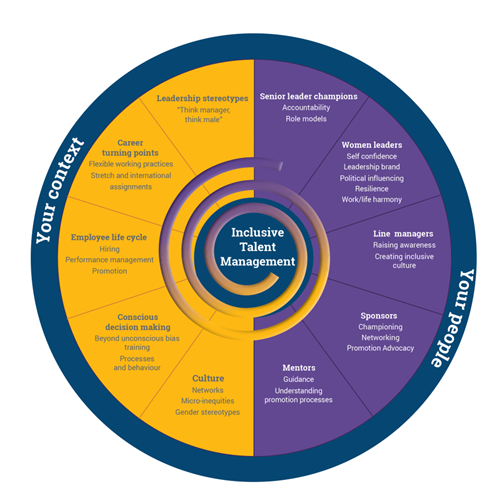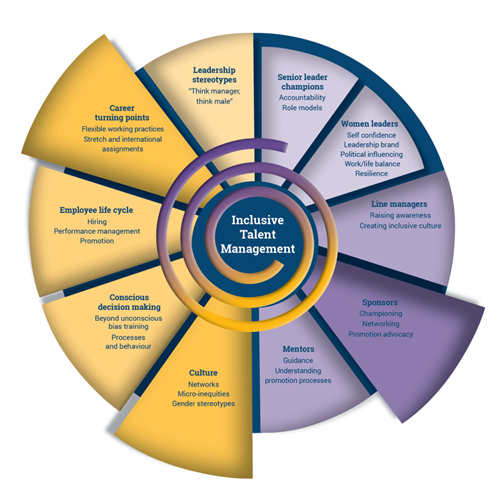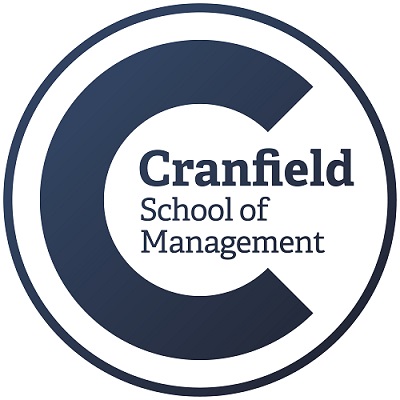- Managing people
Moving On Up
Cranfield’s Kim Turnbull James, Susan Vinnicombe and Hilary Harris offer a gender perspective on practical inclusive talent management for senior roles
Gender diversity at work - Cranfield’s view
The business case for gender diversity at work is well established. Most CEOs can articulate with great passion why it is important to have diverse teams for a successful business. Indeed, it is primarily this business case behind the efforts to bring women into more senior positions. Over the past fifteen years or so, the amounts invested by big corporates and other organizations are amazing, yet the results are pitiful. Whilst many organizations can show virtual parity in the numbers of men and women graduates they recruit, the figures have not much changed at the very top. In FTSE 100 companies there are still only seven female CEOs and fewer than 10% of executive directors on FTSE 100 boards are women.
Research shows that organizations tend to address gender diversity by focusing on developing women but then then do not take much further action, even when they have diversity polices in place. Indeed, women’s leadership programs have become de rigueur in organizations and all major business schools have their own to offer too. Much effort has been invested in women’s networks and allocating mentors to younger women. The success of Sheryl Sandburg's book ‘Lean In’ has certainly driven these initiatives, but even she now admits that when women do lean in as much as men, the rewards are less. However well intentioned, this does not address the fundamental behavioural changes that are required of women and men in order to transform a culture into a truly inclusive one, where everyone's talents are recognized and rewarded.
At Cranfield we have specialized in the whole topic of developing women business leaders for over thirty years. A dedicated research centre informs our executive development for women. We have offered two public programs: one for women aspiring to leadership positions and one for women directors. We have also run many in house programs tailored specifically for the commissioning organization. In the past few years it has become increasingly evident to us that focusing exclusively, or even primarily, on the women does nothing to change the culture of the organization where they work. Women love the programs and claim to learn a lot about how to 'lean in', but whilst they may return to work and get promoted, participants coming from the same organizations in subsequent years report that there is little overall change in the situation for women in their organization. Clearly, we needed to rethink our approach. One way was by gathering the career-blocking issues identified by female program participants about their organizations through the programs, in a way that would not identify individuals, and sharing this back to the organization. Program sponsors valued this feedback, but it was not enough to bring about system change.
Through our partnership with HSBC’s HOST organization in the past two years, we have begun to recognize the value and importance of practical changes in support of inclusive talent management and a gender balanced leadership team, with regular honest reflection between us and the leadership team on outcomes. We are constantly evolving our thinking and are grateful to the HOST Executive Committee for challenging us and being prepared to take risks.
Our work is timely. The Hampton Alexander report to Government establishes demanding targets for the FTSE 350: 33% women on corporate boards, in executive committees and in the leadership level immediately below the latter by 2020. Whilst targets for raising the number of women on corporate boards has had impressive results- moving from 7% in 1999 to 28% in 2017 across FTSE 100 – this has been achieved almost exclusively through recruiting women as Non-Executive Directors. The new Hampton Alexander targets can only be achieved by addressing fundamental problems with our talent management systems.
Cranfield’s systemic approach to gender and Inclusive Talent Management
A meaningful strategic imperative, driven from the top of the organization, is the first step to instigating change in the position of women in that organization. The CEO and Executive team must recognize the need for change. All executives need to be involved in the process of change and managers held accountable to specific targets and for changes to practices.
Our consulting work has led us to develop a comprehensive set of organizational interventions that go beyond individual learning and mind-set change, (for example the popular individual unconscious bias training), to effect systemic change to the organizational context and assumptions around inclusive leadership practice. We help organizations become conscious of how exclusion, discrimination and disenfranchisement are built into their everyday behaviours and practices. These systemic changes then become the ‘new normal’.
This type of approach is supported by others looking at social change such as Margaret Heffernan’s studies of Wilful Blindness and Iris Bohnet’s work on social engineering: change needs to be rooted in collective behavioural change and driven by data.
Our template for working with organizations is shown in Figure 1.

Figure 1 Cranfield Inclusive Talent management template
It is important to recognize this is not a simple shopping list to pick and choose from. The elements dynamically interact. Thus support from senior leaders can be leveraged for culture change: this is not automatic but using the template enables the organization to see how these elements can create positive loops. We also know that not doing so can create negative loops: senior leaders championing women’s career progress, but without corresponding change in line manager and career life cycle practices, leads to cynicism and distress. Women feel the weight of CEO expectation but also feel blocked in moving forward. What started as good intention may lead to an increase of talented women leaving.
We use the template to find ways of ‘nudging forward’ in the areas which may have the most significance but keeping the ‘whole picture’ and the ‘knock-on impacts’ in mind. We encourage concurrent work across many areas of the template as these need to work synergistically. Thus if a career and leadership program for women is created, how will corresponding changes to organization promotion practices accompany that program? For example, how will processes around promotion nominations change to get high talent-rated women onto the short list? how will such women find out about roles which are often not widely advertised? how can women’s access to key networks improve? and how will traditional assumptions around issues such as career breaks or flexible working be challenged? All of these and more need to be on the agenda to make career progression a reality: different segments of the template must link together dynamically to create a real force for change.
HOST Case Study – Accelerating for Difference (AfD)
HOST (HSBC Operations, Services and Technology) and Cranfield have been working in partnership to create meaningful and embedded change through an iterative application of the Inclusive Talent Management (ITM) template. The strategic imperative to turn up the dials on diversity came from Andy Maguire, Group Chief Operating Officer, as leader of the HOST organization. The Cranfield team, who are authors of this paper, have acted as trusted advisors to Andy’s leadership team within HOST using the ITM template to inform conversations and emergent initiatives, allowing HOST to create a holistic approach with dynamic organizational interconnections.
Andy Maguire, HSBC HOST Group Chief Operating Officer made his position clear in a video sent to all managers across the globe:
‘Fifty percent of the world’s population are women, so we want fifty percent of our new appointments at Global Career Band 0-4s to be women. This will be a visible priority for my team. I will be talking to all of them about their teams, and then I need to make sure that the entire process works. What I need from all of you is pretty simple. I need you to get this right at hiring, performance management and promotion. We will be supporting you to make changes in all these areas. All of you, including the men, need to make sure that you’re playing your part in this.’
Alongside Andy’s personal commitment, the data was clear. With too few women in the layer immediately below the HOST Executive Committee (ExCo), action was needed to make sure that women, rated as having the potential to be promoted to this layer, were promoted. Data showed that women stayed in the promotion pipeline for longer than their similarly-rated male peers. Movement in this and the next layer down could therefore start to change the number of women in senior positions and nudge movement throughout the organization. Andy’s ExCo were clear about his expectations on them, the opportunity, and the strategic imperative for change.
Women were individually selected for ‘Accelerating for Difference’ from the two career bands below the HOST ExCo. Each of them were already in significant senior management roles, were high talent rated and said they wanted promotion. The program began with one-off strategic career and leadership workshops run by Cranfield, as distinct from the yearly portfolio of development activities in HOST. The onus of responsibility for getting promoted was not to be passed on to these women as if they ‘need fixing’ in some way. Rather, the workshops would prepare women to be placed in a global talent pool of around 200 women, enhancing visibility for promotion to executive grades. This would be the ‘go to’ pool for short-listing. Each workshop featured senior women speakers and global ExCo engagement. Selectors for posts at the top level anywhere in the world must now consider whether anyone from this talent pool should be on the short list. Globally, succession plans must now be examined to ensure they include senior women high-rated for promotion. So far, two workshops at the upper band level and four at the lower band have been run.
HOST ExCo members acted as sponsors for the upper band participants. The initial idea was for them to champion both their sponsees’ career progression and also to receive reverse mentoring from their sponsees so that they would learn more about their career experiences. This has now evolved into a reciprocal mentoring scheme run as a parallel initiative led by a specialist consulting group introduced by Cranfield to HOST. Women in the senior band act as mentors for women in the lower band.
The workshops provide a forum for women to raise issues in an informal setting with the HOST ExCo. The participants did not hold back in challenging accepted thinking on management practices – explaining that these were different in different countries, and highlighting the degree of action needed to start to change things. The workshops provided a catalyst and an environment for these honest and robust discussions to take place.
In response to the participant’s challenges, we were invited to discuss the way forward with the HOST ExCo. It was clear that many women did not work in an inclusive culture. Helping line managers around the world to become inclusive leaders became a key element of the initiative. This began with Andy communicating his case for change and appointment targets to the global managerial population. It was recognized that line managers needed to understand what had to change in practice and in detail: the second stage consisted of giving managers practical advice on how to behave inclusively and how to change their organization processes to ensure women would be fairly included in promotion opportunities.
As partners in this development, we raised our concerns about unconscious bias training as the sole mechanism for changing line manager behaviour. This is popular with many organizations and certainly stimulates awareness of biases. However, unconscious bias training has been criticised as many managers believe if something is unconscious they cannot change. It has even been suggested that this results in ‘moral licensing’ whereby people do the training but feel no responsibility for change. We proposed to introduce our ‘Conscious Decision Making’ approach (CDM) which focuses on the key processes managers need to bring to mindful attention to change outcomes. For HOST, this focused on hiring, performance management and promotion – all of which have been shown to bias against women moving their careers forward as fast as male counterparts.
Cranfield and HOST co-delivered CDM webinars for line managers across the world. These were reinforced with videos in which HOST ExCo members and the authors of this paper introduced the specific actions and processes required to avoid bias in hiring, performance management and promotion. The overall process began with senior leaders, but grew into an organization-wide intervention as we show in Figure 2.

Figure 2 The emergent Accelerating for Difference interventions for HSBC HOST
As each element of the template is engaged, new challenges emerge. In our workshops many women highlighted that while they had been internationally mobile, living or working in more than one country across their careers to date, they were overlooked for senior executive roles, as current international mobility is a key criterion. Shifting families to new countries can be hard on both men and women, but it can be a showstopper for women, who still have primary family care responsibilities in many parts of the world. This criterion has provided lively discussion at dinners, in webinars and in mentoring.
For example, one woman asked why, after living on several continents during her career, it was necessary to be mobile again, given her role in IT in India – arguably one of the best places in the world to be in that field. The discussions have led to a greater understanding of what international mobility can mean in a modern banking context: the role of secondments, short-term assignments, heading-up global teams, frequent global travel, and more, have all been discussed in terms of their contribution to promotion to senior executive levels.
Has the AfD process really changed the situation as women find themselves, in technical roles in the tough banking sector?
The data indicates a correlation between career movement (lateral or vertical position change) and participation in the AfD program, particularly in relation to vertical moves. Almost half of all participants experienced some form of career movement
The majority of participants who experienced promotion were in the lower career bands. This could reflect more limited opportunities for promotion at the most senior levels, or the fact that this type of move takes longer to achieve. Those who have experienced a position change only are more evenly spread between seniority groups.
However, the program’s target of achieving 30% women in 2017 at senior grades has not been met (it is currently 25%) so there is still much more to do as the program moves into its third year. The focus on system changes and support mechanisms both within and around the program will continue, informed by a deepening understanding of the challenges and experiences shared by the participants.
References
Iris Bohnet (2016) What works: Gender Equality by Design, Harvard University Press.
Margaret Heffernan (2011) Wilful Blindness: Why we ignore the obvious, Simon and Schuster.
Sheryl Sandberg (2013) Lean In: Women, work and the will to lead, Alfred A Knopf .
.....................................................................................................................................
THE AUTHORS:
Kim Turnbull James is Professor of Leadership and Executive Learning at Cranfield School of Management, Cranfield University.
Susan Vinnicombe is Professor of Women and Leadership at Cranfield School of Management, Cranfield University.
Hilary Harris is an Associate Executive Development Director, at Cranfield School of Management, Cranfield University
The Cranfield authors would like to acknowledge and thank Jason Davey, Karon Chapman and Chris Briggs from HSBC HOST for their support and for including HOST as a live case study in this article.
ARTICLES YOU MIGHT LIKE
BOOK REVIEW
UCL’s Colin Fisher explains how to understand the invisible forces of group dynamics to build and lead high-performing teams
DEVELOPING LEADERS QUARTERLY MAGAZINE AND WEEKLY BRIEFING EMAILS


































